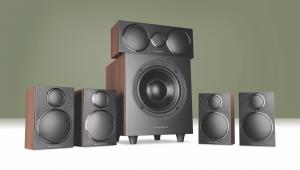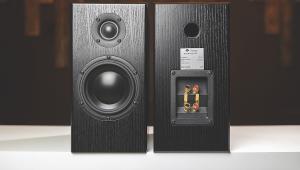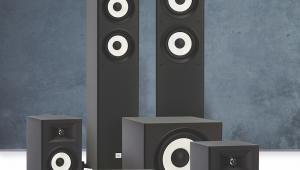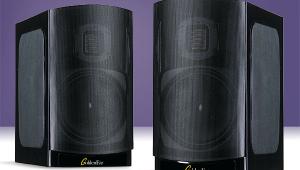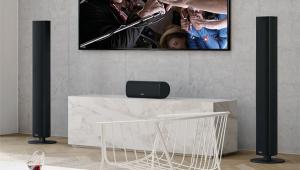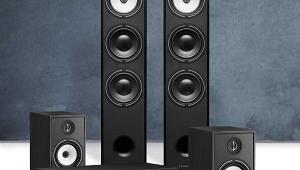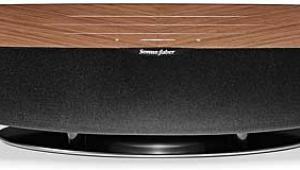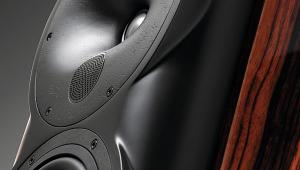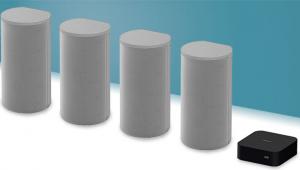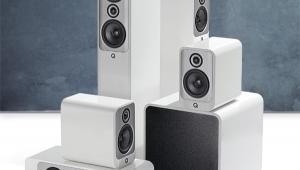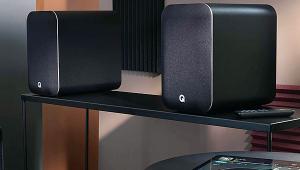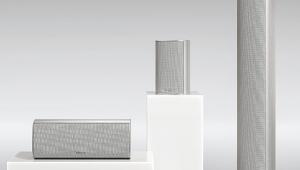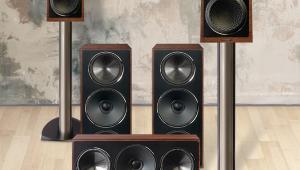KEF R Series Meta 5.1.2 loudspeaker system review
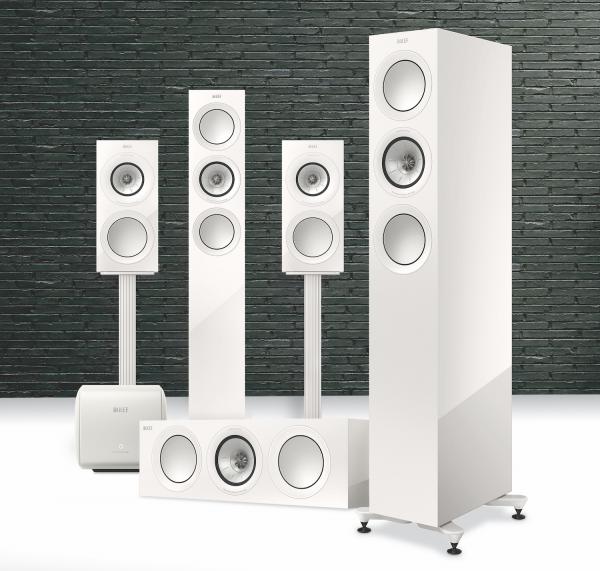
 Now reborn with 'metamaterial' Uni-Q drivers, KEF's R Series puts on an awesome show, says Mark Craven
Now reborn with 'metamaterial' Uni-Q drivers, KEF's R Series puts on an awesome show, says Mark Craven
KEF's Uni-Q driver has been a staple of its loudspeakers since 1988, undergoing various refinements over the years to the point that we're now at its 12th generation. However, not every overhaul has led the audio marque to shout about it in its speaker names, which is what it's doing with the R Series Meta.
KEF's mid-range line of loudspeakers, above its Q Series and below the Reference (and fancy Blade hi-fi models), the R Series is the latest to receive the company's 'Meta' technology. First debuted on the LS50 Meta bookshelf speaker, and more recently added to the Reference and Blade, this is an invisible upgrade to its Uni-Q driver, but one it's claimed makes a serious difference.
Two become one
First, however, for those unfamiliar with KEF speakers, Uni-Q is the name given to its distinctive 'coincident source' mid-range/high-frequency driver array, where the tweeter unit is mounted in the throat of the surrounding mid-range cone. The idea here is to have mid- and high-frequencies emanating from the same point in space, improving the integration of the sound.
On all the R Series Meta speakers, regardless of the size of the cabinet or accompanying bass driver(s), the Uni-Q tweeter is a 1in aluminium dome design, firing through KEF's now familiar 'tangerine' waveguide to better control its dispersion. The mid-range driver, meanwhile, is also made from aluminium, and measures 5in across.
That's the basics, so what about 'Meta'? This refers to the introduction of what KEF calls its Metamaterial Absorption Technology, a sound-absorbing disc placed behind the tweeter assembly. This has a maze-like surface that – like a very smallscale version of an absorption panel in a custom cinema room – aims to effectively eradicate the HF unit's rear-radiating output (well, 99 per cent of it). By removing this 'unwanted sound', says KEF, the result is a huge reduction in distortion and a far smoother treble.
The whole story
KEF's full R Series Meta range runs to seven models. At the very top is the R11 Meta floorstander, which surrounds its 12th-gen Uni-Q unit with four 6.5in hybrid aluminium cone bass drivers, and sells for £5,500.
It's big (1.3m high) so naturally KEF has other floorstanders to tempt you: the R7 Meta (£4,000) opts for just two 6.5in woofers, and the R5 Meta (£3,000) trims its bass driver pairing down to 5.25in designs.
It's this last speaker we have on test here, joined by the R2 Meta centre (£1,200ea), which is the smaller of the range's two centre enclosures and uses 5.25in woofers; a pair of KEF's R8 Meta Dolby Atmos modules (£1,400); and the R3 Meta standmounts for surround channel duty.
Here is where KEF's lineup starts to not quite make perfect sense. With the R3 speaker being the only standmount, it could well be considered by many wanting to build a multichannel setup. Yet its bass units are of the larger size, so if you want to keep all things equal in the system, you'll need to spec either the R7 or R11 floorstanders, and the chunky R6 Meta centre (£1,600). You do wonder if a smaller standmount/bookshelf design might be on the cards.
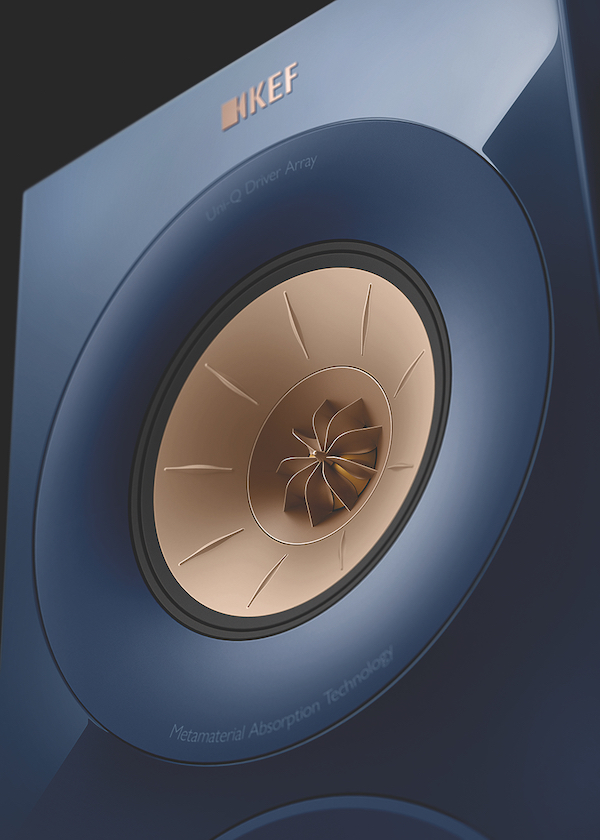
The floorstander and standmount models are ported to the rear, to tune the output of their bass driver(s), delivering a 'typical' in-room LF reach of 29Hz for the R5 Meta, and 30Hz for the R3. KEF's centre speakers are – sensibly – sealed cabinets, as are the R8 Atmos toppers, which feature just a single (two-way) Uni-Q unit.
For this review, KEF supplied the speakers with its ultra-compact KC62 subwoofer, which might not be the most obvious choice (because it sells the more conventional, and larger, KF92), but certainly makes for a neat visual partner if you've gone for the speakers in black or white, rather than walnut. It's more curvy than straight-edged, but fits in very well.
And speaking of finishes, and craftsmanship in general, the R Series Meta might just be the most beautiful loudspeakers I've ever clapped eyes on. The combination of the gloss cabinet finish, the central Uni-Q driver, and the dished aluminium woofers makes these a sight for sore eyes. Everything appears clean, crisp and in proportion, and little details abound that really impress. The feet for the R5 towers are stylish and sturdy, while even the easy-access packaging of this fairly hefty speaker shows a level of attention. And on all models bar the R8, there are dual sets of binding posts for bi-wire/amping, but rather than link these via a metal jumper that might get lost, the connection mechanism is internal, controlled by a dial on the back. Very clever.
All-round excellence
What this 5.1.2 system can achieve, even on the end of fairly modest amplification (I ran it from both Onkyo's affordable TX-NR6100, and a beefier Arcam AVR850), is remarkable. KEF has been in the loudspeaker game long enough to know what makes for a crowd-pleasing sound, so its speakers tend to be all-rounders rather than idiosyncratic. Yet the performance here isn't just about getting all the basics right; it's about doing that, and then some.
The R Series Meta sound is one of seemingly converse elements existing in harmony. These speakers can be boisterous and muscular, detailed and sweet, all at the same time. There's punch and drive at the bottom, air and resolution at the top, and a whole lot of fun in between.
The soundmix of animated Ocean's Eleven wannabe The Bad Guys oozes from this set with all the charm of the film's characters. At the very beginning, we're in a diner, listening to Tarantino-esque banter between Wolf (Sam Rockwell) and Snake (Marc Maron). The dialogue is clear, powerful and articulate through the R2 Meta centre, while the background ambience of the coffee shop and the traffic pootling by outside is nicely layered behind.
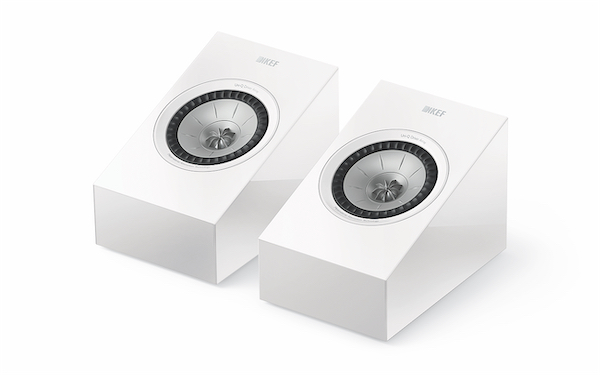
But once they've stood up to pay their bill, the soundmix kicks up a gear, first with the funky, jazzy score, and a rush of extra audio as the doors open and we step outside. Suddenly the stage becomes huge, the surround/Atmos channels and sub swinging into action, and you realise the R Series Meta cabinets have been almost toying with you up until now. The ensuing car chase features roaring engines that are both impressively rich, deep and snarly, but seem to rip a line right across my carpet, such is the steering panache.
Sand me down
Perhaps it is all down to that new-fangled Meta technology, or maybe just the combined experience of 35 years of engineering working its magic, but the mid/high output of all these models is fantastic.
With seven identical Uni-Q drivers all around, the feeling is of musical motifs and effects being passed from one cabinet to another without a gap in the chain. During much of Dune's inventive sound design (4K Blu-ray), the sense is of a soundfield that, while not offering the 360-degree immersion of a 7.1.4 setup, is coming pretty damn close. Hans Zimmer's score continually dispenses from all channels, and it's impossible not to get wrapped up in the drama of it all.
As mentioned earlier, the KC62 might not seem, at first glance, to be a subwoofer of serious impact based on its 25cm approx cube size alone. But its rock-solid enclosure, and innovative overlapping voice coil that allows two 6.5in drivers to occupy a space no bigger than a bowling ball, add up to a remarkable 'good things come in small packages' performance.
It misses out on ultimate bass extension (despite an 11Hz freq. response claim) and sheer scale of output, but the areas it does cover it covers in style. And it dovetails exceptionally well with R5 towers for a low-end performance that marries deep, rich lows with plenty of definition and slam. Nowhere is this more apparent than with Dune's mix of bassy soundtrack notes and an LFE track that adds weight to everything from a closing ship door to footsteps in interiors.
With the bus-based brawl in action/thriller Nobody (Sky Cinema), the KEF speakers show off a lean upper bass range, again helped by the fast and tight KC62 sub, and the control being brought to the woofers in the passive speakers. This sequence impresses first with the claustrophobic staging inside the vehicle, and then really captivates with the knife-tip delivery of all the meaty transients. Fists pummel flesh and skulls crack into metal, and there's not a hint of bloom to the bass or tardiness to the delivery. Some of the gore sounds are wince-inducing.
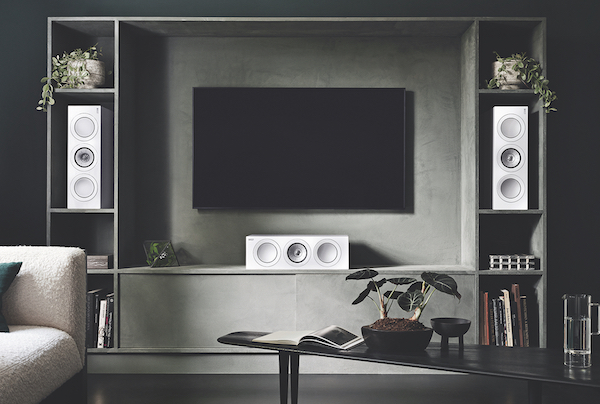
Mission Impossible: Ghost Protocol (4K BD) benefits from the refined delivery of the KEF centre when it comes to the array of different accents; the smartness of this system's handling of panned effects when Ethan Hunt (in long hair mode) chases Hendricks through Mumbai; and the rich, musical presentation of Michael Giacchino's score. Indeed, it perhaps goes without saying that KEF's speakers – the R5s in particular, but also the standmount R3s judging from a brief session using them in stereo – are exemplary hi-fi models.
For anyone interested in using their AV setup for movies and music (as you probably should be if you've just dropped over £9,000 on it), these will take some beating. Daft Punk's 'Give Life Back to Music', from the French duo's fan-fave Random Access Memories album, writes a foot-tapping tempo with its funk bassline and choppy guitar, while soft synth sounds rise and fall in the background. Via the R Series Meta, the smooth, sumptuous quality of the whole thing was as impressive as the low-end poise and grip.
Pick and mix
All that needs to be said at this stage is that £9,200 is a heck of a lot to spend on a 5.1.2 speaker array. Yet KEF's models earn their crust by the sheer listenability of the performance, the achingly cool design and luxurious build. And when you consider their position between the much costlier Reference range and the as-yet un-Meta'd Q Series, it's arguable they mark KEF's sweetspot.
Delectable high-frequencies, seamless handling of panned effects, a spacious, detailed Atmos presentation, bass you can chew on and a centre speaker that doesn't miss a single syllable. Where do I sign?
HCC Verdict: 5/5
KEF R Series Meta 5.1.2
Price: £9,200
uk.kef.com
We say: KEF's Meta rollout reaches its R Series, and the results are impeccable. This 5.1.2 array provides serious (and seriously fun) home cinema sonics from some gorgeous cabinets.
Specifications
R5 Meta
DRIVERS:1 x Uni-Q with 1in aluminium dome tweeter and 5in aluminium mid-range; 2 x 5.25in hybrid aluminium cone bass drivers ENCLOSURE: Twin rear-ported FREQUENCY RESPONSE (CLAIMED): 52Hz-28kHz (+/-3dB) SENSITIVITY (claimed): 87dB IMPEDANCE (claimed): 4ohm (3.2ohm min) POWER HANDLING (claimed): 200W DIMENSIONS (Incl. feet): 1,072(h) x 272(w) x 344(d)mm WEIGHT: 25.5kg
R3 Meta
DRIVERS: 1 x Uni-Q; 1 x 6.5in hybrid aluminium cone bass driver ENCLOSURE: Rear-ported FREQ. RESPONSE (CLAIMED): 58Hz-28kHz (+/-3dB) SENSITIVITY (CLAIMED): 87dB IMPEDANCE (CLAIMED): 4ohm (3.2ohm min) POWER HANDLING (CLAIMED): 180W DIMENSIONS: 422(h) x 200(w) x 336(d)mm WEIGHT: 12.4kg
R2 Meta
DRIVERS: 1 x Uni-Q; 2 x 5.25in hybrid aluminium cone bass drivers ENCLOSURE: Sealed FREQ. RESPONSE (CLAIMED): 67Hz-28kHz (+/-3dB) SENSITIVITY (CLAIMED): 87dB IMPEDANCE (CLAIMED): 4ohm (3.2ohm min) POWER HANDLING (CLAIMED): 200W DIMENSIONS: 175(h) x 550(w) x 309(d)mm WEIGHT: 15.4kg
R8 Meta
DRIVERS: 1 x Uni-Q ENCLOSURE: Sealed FREQ. RESP (CLAIMED): 97Hz-17.5kHz (+/-3dB) SENSITIVITY (CLAIMED): 85dB IMPEDANCE (CLAIMED): 4ohm (3.2ohm min) POWER Han. (CLAIMED): 150W DIMENSIONS: 174(h) x 175(w) x 259(d)mm WEIGHT: 4.5kg
KC62 (subwoofer)
DRIVERS: 2 x 6.5in woofers ENCLOSURE: Sealed, force-cancelling config ONBOARD POWER (CLAIMED): 2 x 500W (RMS) FREQ. RESPONSE (CLAIMED): 11Hz-290Hz REMOTE CONTROL: No DIMENSIONS: 246(h) x 256(w) x 248(d)mm WEIGHT: 14kg FEATURES: Stereo/LFE line-level input; speaker-level input; line-level output; room/wall/corner/cabinet/apartment preset EQs; crossover and phase control
 |
Home Cinema Choice #351 is on sale now, featuring: Samsung S95D flagship OLED TV; Ascendo loudspeakers; Pioneer VSA-LX805 AV receiver; UST projector roundup; 2024’s summer movies; Conan 4K; and more
|




